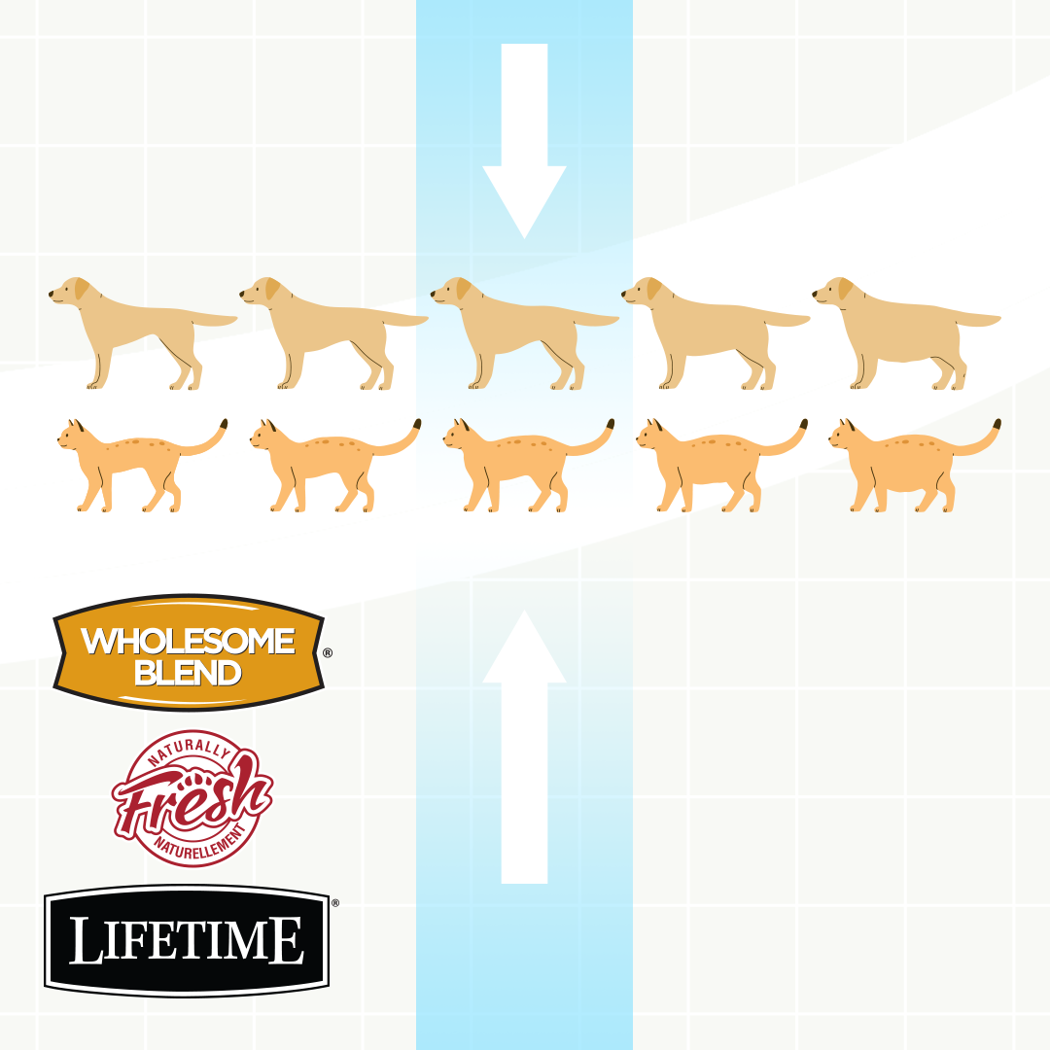Obesity: the hard treat to swallow
- Health
- Dog
- Cat
For dogs and cats, obesity is defined as being 30% above their ideal body weight or having a body condition of 4.5 or greater on a 5-point scale (Pet Obesity Prevention, 2019). In 2018, almost 19% of dogs and 34% of cats in the United States were obese (Pet Obesity Prevention, 2018). These are sobering numbers that don’t seem to be on the verge of declining.

The impacts of obesity
Obesity increases the prevalence of several health conditions that not only impact your pet’s life but can result in increased veterinarian bills.
Approximate median treatment costs:
- Osteoarthritis: dogs-$2,600/year; cats-$460/year
- Urinary tract infections (due to inability to properly groom): dogs and cats-$840
- Diabetes: dogs-$1,800/year; cats-$1,300/year
- Hypertension: dogs-$2,700/year; cats-$2,000/year
*Treatment costs were converted to CAD and adjusted for inflation (Berr, 2017; DVM360, 2009).
On a positive note, the prognosis of these conditions can be improved with weight loss (Marshall et al, 2010; German et al, 2009; Tvarijonaviciute et al, 2012; Rocchini et al, 1987).
In addition to the increased prevalence of certain diseases, obese pets have a reduced quality of life and have a shortened lifespan when they carry excess weight (Kealy et al, 2002; German et al, 2012). This is not saying that your pet isn’t happy or you are not providing your pet with a great life, but studies show they enjoy life more after weight loss as they are more energetic/enthusiastic and show decreased levels of pain and emotional disturbance (German et al, 2012; Yam et al, 2016).
Determining body condition by rib palpation
Ideal weight- Run your fingers over the back of your hand. The bones can be easily felt under the minimal fat pad. This is what you’ll feel when you palpate the ribs of a pet that is a healthy weight.
Overweight/obese- Palpate the palm of your hand. The bones in your hand are difficult to feel due to the thick fat pad. This is what you will feel when you palpate the ribs of an overweight/obese pet.
Use our body condition score document as a guide to help determine if your dog or cat is the ideal body weight.
Reframing our minds
One of the biggest culprits of the obesity epidemic in pets is human's perception of ideal weight. We have acclimated to a world where the majority of pets are overweight/obese, so our perception of the ideal weight has shifted. We now view pets that are the ideal weight as being too skinny and the overweight pet as ideal (Eastland-Jones et al, 2013).
Ideal weight is when your pet’s ribs can be easily felt but not seen and when you look at your pet from above, there is an obvious waist.
Take action
If you believe your pet is obese consult your veterinarian, who will be able to create a safe and customized weight-loss program for your pet. You must seek professional guidance as underlying health conditions and rapid weight loss could pose health risks to your pet.
Sources
Berr, J. (2017, January 4). The high cost of pet obesity. Retrieved from https://www.cbsnews.com/news/the-high-cost-of-pet-obesity/
DVM360. (2009). Counting the cost of chronic disease. Retrieved from https://www.dvm360.com/view/counting-cost-chronic-disease
Eastland-Jones, R. C., German, A. J., Holden, S, L & Biourge, V. (2013). Owner misperception of canine body condition persists despite use of a body condition score chart. Journal of Nutritional Science, 3(45). doi:10.1017/jns.2014.25
German, A. J., Hervera, M., Hunter, L., Holden, S. L., Morris, P. J., Biourge, V & Trayhurn, P. (2009). Improvement in insulin resistance and reduction in plasma inflammatory adipokines after weight loss in obese dogs. Domestic Animal Endocrinology, 37(4), 214-226. https://doi.org/10.1016/j.domaniend.2009.07.001
German, A. J., Holden, S. L., Wiseman-Orr, M. L., Reid, J., Nolan, A. M., Biouge, V & Morris, P. J. (2012). Quality of life is reduced in obese dogs but improves after successful weight loss. The Veterinary Journal, 192, 428-434. doi: 10.1016/j.tvjl.2011.09.015
Kealy, R. D., Lawler, D. F., Ballam, J. M., Mantz, S. L., Biery, D. N., Greeley, E. H., Lust, G., Segre, M., Smith, G. K & Howard, D. S. (2002). Effects of diet restriction on life span and age-related change in dogs. Journal of the American Veterinary Medical Association, 220(9), 1315-20
Lund, E.M., Armstrong, P. J., Kirk, C. A., Klausner, J. S. (2005). Prevalence and Risk Factors for Obesity in Adult Cats from Private US Veterinary Practices. The International Journal of Applied Research in Veterinary Medicine, 3(2).
Lund, E.M., Armstrong, P. J., Kirk, C. A., Klausner, J. S. (2006). Prevalence and Risk Factors for Obesity in Adult Dogs from Private US Veterinary Practices. The International Journal of Applied Research in Veterinary Medicine, 4(2).
Marshall, W. G., Hazewinkel, H. A. W., Mullen, D., Meyer, G. D., Baert, K & Carmichael, S. (2010). The effect of weight loss on lameness in obese dogs with osteoarthritis. Veterinary Research Communications, 34(3), 241-253.
Pet Obesity Prevention. (2018). The Global Pet Obesity Initiative Position Statement. Retrieved from https://static1.squarespace.com/static/597c71d3e58c621d06830e3f/t/5da311c5519bf62664dac512/1570968005938/Global+pet+obesity+initiative+position+statement.pdf
Pet Obesity Prevention. (2018). U.S Pet Obesity Survey Results. Retrieved from https://petobesityprevention.org/2018
Rocchini, A. P., Moorehead, C., Wentz, E & Deremer, S. (1987). Obesity-induced hypertension in the dog. Hypertension, 9(6). Retrieved from https://www.ahajournals.org/doi/pdf/10.1161/01.HYP.9.6_Pt_2.III64
Tvarijonaviciute, A., Ceron, J. J., Holden, S. L., Morris, P. J., Biourge, V & German, A. J. (2012). Effects of weight loss in obese cats on biochemical analytes related to inflammation and glucose homeostasis. Domestic Animal Endocrinology, 42(3), 129-141. https://doi.org/10.1016/j.domaniend.2011.10.003
Yam, P. S., Butowski, C. F., Chitty, J. L., Naughton, G., Wiseman-Orr, M. L & Parkin, T. (2016). Impact of canine overweight and obesity on health-related quality of life. Preventative Veterinary Medicine. 127, 64-69. DOI: 10.1016/j.prevetmed.2016.03.013